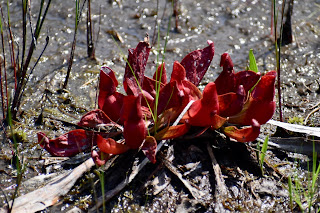Pine Barrens Bogs
Until the shorebirds start returning from their northern breeding grounds, Ocean County birding in early July can be monotonous. So while the shorebirds slowly trickle back, I’ve tried a couple bog spots over the past week hoping to find other non-avian critters. A friend introduced me to Webb’s Mill Bog last week. The bog is part of the Greenwood Wildlife Management Area in either Lacey Township or Manchester Township (depending on which website you visit). The bog trail is a raised boardwalk only about a quarter mile long, however it is only accessible from the side of the road along a county highway. I made two trips there and one to the cranberry bogs in Berkeley Township, which is also only accessible from the side of the road along a county highway.
Webb’s Mill Bog is a known place for Pine Barrens treefrogs and some rare, endangered or vulnerable plant species. On the first trip there, my hope was to see a Pine Barrens treefrog, but I knew that would be a difficult task. Although it is bright green, it is not quite two inches long and sits nestled on branches of the cedar trees that make up the forest around the bog. The frogs were calling that day, but I could not get my eyes on one. I guess I was lucky for that audible encounter. The treefrogs stop calling in early July and on my second visit they were silent. New Jersey is a stronghold for these frogs, so I’ll have to wait until next spring to find one.
There were interesting plants living at Well’s Mill, even to a non-botanist like me. I am fond of carnivorous plants, and there were many at this location. Purple pitcher plants, thread leaf sundews, spoon leaf sundews, and even some round leaf sundews were very easy to spot around the boardwalk trail. Many of them were flowering. Carnivorous plants like these, and also Venus flytraps, set their flowers on top of stalks high above the plant body. This ensures that the pollinators can do their jobs and not be lured into the plants’ traps.
Dragonflies and damselflies are the more common flying creatures seen at the bogs this time of year. Both bogs hosted several species. Common ones seen were skimmers, pondhawks, whitetails, pennants, bluets and saddlebags. I did find a couple that were new to me, a seepage dancer and a scarlet bluet.
As the shorebirds continue to return in increasing numbers, I will gladly turn my attention back to the beaches and sedges at the Jersey Shore.





















Comments
Post a Comment